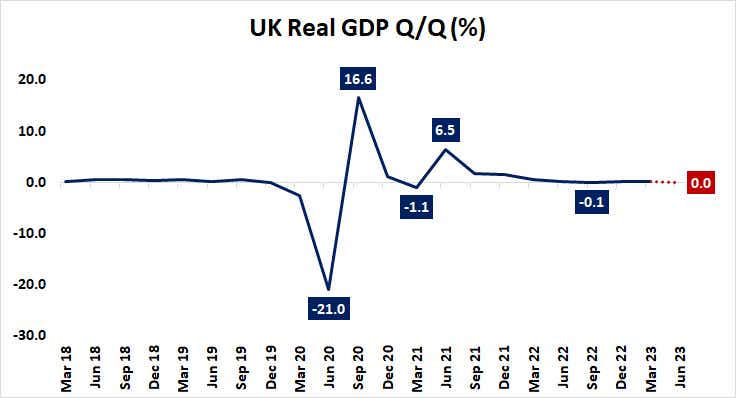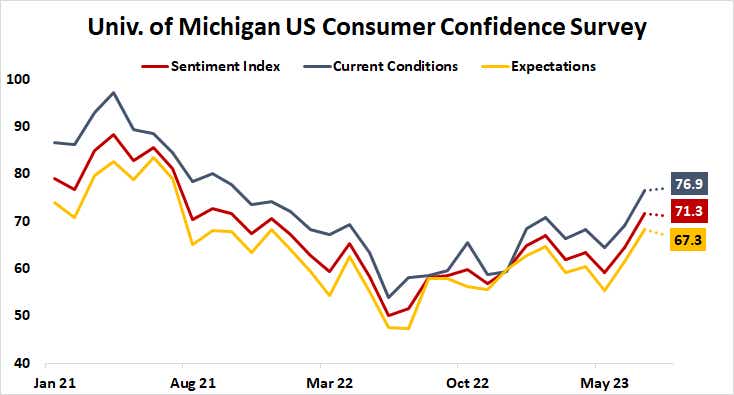As Global Recession Worries Grow, Markets Look to U.S. Consumers for a Lifeline

As Global Recession Worries Grow, Markets Look to U.S. Consumers for a Lifeline
By:Ilya Spivak
If consumers don't rally, stocks may keep falling as the dollar gains
- Stocks swoon, dollar gains despite "goldilocks" U.S. inflation data.
- U.K. GDP data to show the economy stalled in the second quarter.
- Health of U.S. consumers is critical and the University of Michigan sentiment survey is in focus.
July’s U.S. consumer price index (CPI) data was seemingly as benign as the markets might have hoped for. Veering too far away from baseline forecast one way or the other seemed fraught with danger ahead of the release.
As it happened, headline inflation came in at 3.2% year-on-year, a touch softer than the 3.3% expected. That seems about as supportive for risk-taking as traders could want: a touch soft to keep Federal Reserve hawks at bay, but not so weak as to sound the alarm about economic growth.
The response from stock prices was decidedly darker. The bellwether S&P 500 stock index briefly popped higher, then violently turned in the opposite direction. In tandem, the U.S. dollar probed weekly lows only to reverse sharply upward a mere 90 minutes later, erasing the data-driven selloff and then some.
Winter is coming?
It seems telling that the bulls were swiftly routed in the wake of economic data that ought to have put a pep in their step. They might yet manage to win back some ground before the closing bell is sounded on Wall Street. Nevertheless, the weakness on display so far suggests the pendulum swing against them is gathering steam.
The markets’ response to last week’s U.S. jobs report was similarly dour: a data set that might have been celebrated as just ‘goldilocks’ enough—much like the CPI print—concluded in stocks slumping and the greenback on the rise. Whatever investors are afraid of, they seem to be increasingly defensive.
Worries about a broad-based business cycle downshift are a likely culprit. The Fed estimates it can take 12 to 18 months for the impact of a single rate rise to be fully absorbed into the economy. So, pressure from the bulk of last year’s outsized 50- and 75-basis-point rate hikes ought to be appearing right about now.
Global economy on the ropes
Meanwhile, the global backdrop is sobering. The Eurozone is flirting with recession, if not already in one. Germany’s economy—the bloc’s largest—shrank 0.6% in the second quarter. Purchasing manager index (PMI) data suggests regional manufacturing- and service-sector activity contracted in July, implying that the weakness is spreading.
China—the world’s second-largest economy—is still struggling to recover after reopening from “zero-COVID” restrictions in December. Trade data published earlier this week was even weaker than the markets’ timid forecasts (as expected), while inflation fell below zero for the first time since the pandemic lows of late 2020 to early 2021.

Up next, U.K. gross domestic product (GDP) data is expected to show the economy has stalled in the three months to June, a worse result than even the pitiful 0.1% expansions recorded in the prior two quarters. It may be weaker still, considering data from Citigroup showing U.K. economic outcomes have increasingly softened relative to forecasts.
U.S. consumers to the rescue?
With Europe and China in dire straits, the United States amounts to the last line of defense still standing against a global slump. That puts the burden squarely on U.S. consumers. So, a closely watched report on their disposition from the University of Michigan might find a still broader audience when it is released on Friday.
Economists’ forecasts suggest that while the assessment of current conditions will hold up, the broader sentiment index will be pulled lower as forward-looking expectations deteriorate. If markets walk away from the release with a sense that consumer appetite is waning, the “risk off” drive will probably accelerate.

Ilya Spivak, tastylive head of global macro, has 15 years of experience in trading strategy, and he specializes in identifying thematic moves in currencies, commodities, interest rates and equities. He hosts Macro Money and co-hosts Overtime, Monday-Thursday. @Ilyaspivak
For live daily programming, market news and commentary, visit tastylive or the YouTube channels tastylive (for options traders), and tastyliveTrending for stocks, futures, forex & macro.
Trade with a better broker, open a tastytrade account today. tastylive, Inc. and tastytrade, Inc. are separate but affiliated companies.
Options involve risk and are not suitable for all investors. Please read Characteristics and Risks of Standardized Options before deciding to invest in options.
tastylive content is created, produced, and provided solely by tastylive, Inc. (“tastylive”) and is for informational and educational purposes only. It is not, nor is it intended to be, trading or investment advice or a recommendation that any security, futures contract, digital asset, other product, transaction, or investment strategy is suitable for any person. Trading securities, futures products, and digital assets involve risk and may result in a loss greater than the original amount invested. tastylive, through its content, financial programming or otherwise, does not provide investment or financial advice or make investment recommendations. Investment information provided may not be appropriate for all investors and is provided without respect to individual investor financial sophistication, financial situation, investing time horizon or risk tolerance. tastylive is not in the business of transacting securities trades, nor does it direct client commodity accounts or give commodity trading advice tailored to any particular client’s situation or investment objectives. Supporting documentation for any claims (including claims made on behalf of options programs), comparisons, statistics, or other technical data, if applicable, will be supplied upon request. tastylive is not a licensed financial adviser, registered investment adviser, or a registered broker-dealer. Options, futures, and futures options are not suitable for all investors. Prior to trading securities, options, futures, or futures options, please read the applicable risk disclosures, including, but not limited to, the Characteristics and Risks of Standardized Options Disclosure and the Futures and Exchange-Traded Options Risk Disclosure found on tastytrade.com/disclosures.
tastytrade, Inc. ("tastytrade”) is a registered broker-dealer and member of FINRA, NFA, and SIPC. tastytrade was previously known as tastyworks, Inc. (“tastyworks”). tastytrade offers self-directed brokerage accounts to its customers. tastytrade does not give financial or trading advice, nor does it make investment recommendations. You alone are responsible for making your investment and trading decisions and for evaluating the merits and risks associated with the use of tastytrade’s systems, services or products. tastytrade is a wholly-owned subsidiary of tastylive, Inc.
tastytrade has entered into a Marketing Agreement with tastylive (“Marketing Agent”) whereby tastytrade pays compensation to Marketing Agent to recommend tastytrade’s brokerage services. The existence of this Marketing Agreement should not be deemed as an endorsement or recommendation of Marketing Agent by tastytrade. tastytrade and Marketing Agent are separate entities with their own products and services. tastylive is the parent company of tastytrade.
tastyfx, LLC (“tastyfx”) is a Commodity Futures Trading Commission (“CFTC”) registered Retail Foreign Exchange Dealer (RFED) and Introducing Broker (IB) and Forex Dealer Member (FDM) of the National Futures Association (“NFA”) (NFA ID 0509630). Leveraged trading in foreign currency or off-exchange products on margin carries significant risk and may not be suitable for all investors. We advise you to carefully consider whether trading is appropriate for you based on your personal circumstances as you may lose more than you invest.
tastycrypto is provided solely by tasty Software Solutions, LLC. tasty Software Solutions, LLC is a separate but affiliate company of tastylive, Inc. Neither tastylive nor any of its affiliates are responsible for the products or services provided by tasty Software Solutions, LLC. Cryptocurrency trading is not suitable for all investors due to the number of risks involved. The value of any cryptocurrency, including digital assets pegged to fiat currency, commodities, or any other asset, may go to zero.
© copyright 2013 - 2025 tastylive, Inc. All Rights Reserved. Applicable portions of the Terms of Use on tastylive.com apply. Reproduction, adaptation, distribution, public display, exhibition for profit, or storage in any electronic storage media in whole or in part is prohibited under penalty of law, provided that you may download tastylive’s podcasts as necessary to view for personal use. tastylive was previously known as tastytrade, Inc. tastylive is a trademark/servicemark owned by tastylive, Inc.